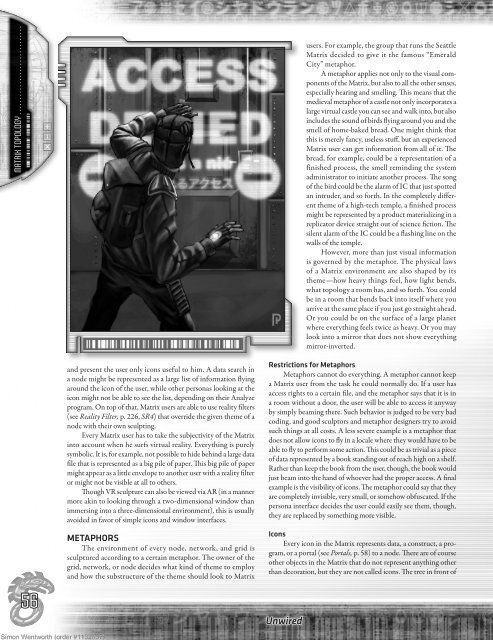comStar Firewall alert - PhaseThrough
comStar Firewall alert - PhaseThrough
comStar Firewall alert - PhaseThrough
You also want an ePaper? Increase the reach of your titles
YUMPU automatically turns print PDFs into web optimized ePapers that Google loves.
Matrix topoloGy . . . . . . . . . . . . . . . . . . . . . . . . . . . . .<br />
56<br />
and present the user only icons useful to him. A data search in<br />
a node might be represented as a large list of information flying<br />
around the icon of the user, while other personas looking at the<br />
icon might not be able to see the list, depending on their Analyze<br />
program. On top of that, Matrix users are able to use reality filters<br />
(see Reality Filter, p. 226, SR4) that override the given theme of a<br />
node with their own sculpting.<br />
Every Matrix user has to take the subjectivity of the Matrix<br />
into account when he surfs virtual reality. Everything is purely<br />
symbolic. It is, for example, not possible to hide behind a large data<br />
file that is represented as a big pile of paper. This big pile of paper<br />
might appear as a little envelope to another user with a reality filter<br />
or might not be visible at all to others.<br />
Though VR sculpture can also be viewed via AR (in a manner<br />
more akin to looking through a two-dimensional window than<br />
immersing into a three-dimensional environment), this is usually<br />
avoided in favor of simple icons and window interfaces.<br />
MetapHorS<br />
The environment of every node, network, and grid is<br />
sculptured according to a certain metaphor. The owner of the<br />
grid, network, or node decides what kind of theme to employ<br />
and how the substructure of the theme should look to Matrix<br />
Unwired<br />
users. For example, the group that runs the Seattle<br />
Matrix decided to give it the famous “Emerald<br />
City” metaphor.<br />
A metaphor applies not only to the visual components<br />
of the Matrix, but also to all the other senses,<br />
especially hearing and smelling. This means that the<br />
medieval metaphor of a castle not only incorporates a<br />
large virtual castle you can see and walk into, but also<br />
includes the sound of birds flying around you and the<br />
smell of home-baked bread. One might think that<br />
this is merely fancy, useless stuff, but an experienced<br />
Matrix user can get information from all of it. The<br />
bread, for example, could be a representation of a<br />
finished process, the smell reminding the system<br />
administrator to initiate another process. The song<br />
of the bird could be the alarm of IC that just spotted<br />
an intruder, and so forth. In the completely different<br />
theme of a high-tech temple, a finished process<br />
might be represented by a product materializing in a<br />
replicator device straight out of science fiction. The<br />
silent alarm of the IC could be a flashing line on the<br />
walls of the temple.<br />
However, more than just visual information<br />
is governed by the metaphor. The physical laws<br />
of a Matrix environment are also shaped by its<br />
theme—how heavy things feel, how light bends,<br />
what topology a room has, and so forth. You could<br />
be in a room that bends back into itself where you<br />
arrive at the same place if you just go straight ahead.<br />
Or you could be on the surface of a large planet<br />
where everything feels twice as heavy. Or you may<br />
look into a mirror that does not show everything<br />
mirror-inverted.<br />
restrictions for Metaphors<br />
Metaphors cannot do everything. A metaphor cannot keep<br />
a Matrix user from the task he could normally do. If a user has<br />
access rights to a certain file, and the metaphor says that it is in<br />
a room without a door, the user will be able to access it anyway<br />
by simply beaming there. Such behavior is judged to be very bad<br />
coding, and good sculptors and metaphor designers try to avoid<br />
such things at all costs. A less severe example is a metaphor that<br />
does not allow icons to fly in a locale where they would have to be<br />
able to fly to perform some action. This could be as trivial as a piece<br />
of data represented by a book standing out of reach high on a shelf.<br />
Rather than keep the book from the user, though, the book would<br />
just beam into the hand of whoever had the proper access. A final<br />
example is the visibility of icons. The metaphor could say that they<br />
are completely invisible, very small, or somehow obfuscated. If the<br />
persona interface decides the user could easily see them, though,<br />
they are replaced by something more visible.<br />
icons<br />
Every icon in the Matrix represents data, a construct, a program,<br />
or a portal (see Portals, p. 58) to a node. There are of course<br />
other objects in the Matrix that do not represent anything other<br />
than decoration, but they are not called icons. The tree in front of<br />
Simon Wentworth (order #1132857) 9


